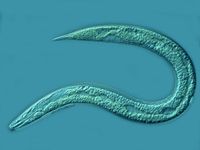Nematodes
Overview

According to the Merriam-Webster Dictionary, Nematode is defined as, "Any of a phylum (Nematoda or Nemata) of elongated cylindrical worms parasitic in animals or plants or free-living soil or water". Nematodes are the most diverse, and adapted phylum of metazoans and are found all over the earth in many different regions. There are expected to be around 50,000 species of Nematodes that exist today. Nematodes are one of many phyla that are classified as a protostome, although they do not follow with Annelids because of the Nematode's tubular design.
Anatomy
The body of a nematode is long and narrow; The term nema is a greek work meaning thread, a close resemblance to the body shape of a nematode. A nematode is a very unique yet simple organism when you take notice of it's anatomy. The only muscles that a Nematode has all run longitudinally along the inside of it's body, therefore a nematode can only wiggle side to side and no other way. These muscles lie just below the epidermis and around the gut cavity. The epidermis of a nematode is very unique because it is a mass of cellular material and nuclei without separate membranes. This is unusual because most animals have an epidermis comprised of cells. A very important feature of the epidermis is that is secretes a thick outer cuticle that serves as a relative exoskeleton for the nematode, although this is far from being a true exoskeleton. Arthropods and Ecdysozoans are two other groups of animals that commonly shed their cuticle multiple times before adulthood.
There are only two nerves in a nematode, a ventral nerve, and a dorsal nerve. The ventral nerve runs along the bottom of the nematode and runs the entire length of the nematode. The ventral nerve has many "nerve centers" along its length. The dorsal nerve runs along the back(top) of the nematode for the entire length as well. Both nerves are connected by a nerve ring near the head of the nematode. Unlike most animals, the muscle cells of a nematode actually run towards the nerve cells.
The digestive system of a nematode is very simple; There is a head with some sensory organs, a mouth that leads to a throat that is designed to increase the surface area of the food, a gut cavity along the nematode, and leaving through the anus. The nutrients in the food are dispersed along the cavity of the nematode, where it is regulated by an excretory canal along its sides.
There is no specialized respiratory system in nematodes, nor is there a specialized vascular system. Nematodes rely on diffusion in order to obtain its oxygen and nutrients. Diffusion is a movement of molecules from a high concentration to a low concentration, which is how the molecules travel into the nematode when it needs it. This is helpful because a nematode doesn't need complex organs to breathe unlike humans.
The process that truly allows for nematodes to live in harsh conditions is called cryptobiosis; a feature that allows nematodes to completely put a halt to its life functions. Allowing nematodes to "turn-off" when conditions are unfavorable, and to "turn-on" when they are in more suitable conditions. [1]
Cryptobiosis
References
- ↑ nematode anatomy